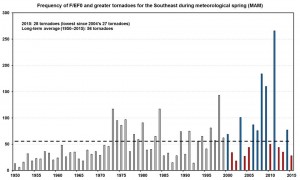A new study released by NOAA last week shows that in El Nino years, the number of tornadoes and hail storms decreases compared to non-El Nino years. As you might expect, in La Nina years, the opposite of El Nino, severe weather increases in the Southeast. Note the split between the Florida peninsula and more northern parts of the region,though. You can read more about these results by clicking here.
Jordan McLeod of the Southeast Regional Climate Center also posted an interesting graph today about the number of tornadoes in the Southeast over time. Here is what he said about the graph:
“Since meteorological spring (March-May) is now behind us, I thought I would provide some perspective on where this past spring’s tornado activity across the Southeast (AL, GA, FL, SC, NC, VA) ranked compared to the climatological record. There were a total of 28 confirmed tornadoes across the Southeast Regional Climate Center(SERCC) region during spring 2015, with 24 of these tornadoes occurring during April. Based on the official NOAA NWS Storm Prediction Center tornado database, this was the lowest count of spring tornadoes since 2004. What is particularly interesting to me is the high degree of interannual variability in tornado counts during the period of record. For example, I’ve indicated in red all years since 2000 with a below-average count of spring tornadoes and colored in blue all years with an above-average count of spring tornadoes. During this 16-year period, 8 years were blue, and 8 years were red. In other words, there is a lot of variability in tornado activity across the Southeast from one year to the next. (By the way, the values prior to the mid-1970s are less reliable due to a variety of factors, including a smaller population density, lack of Doppler radar technology, and less sophisticated reporting techniques.)”

